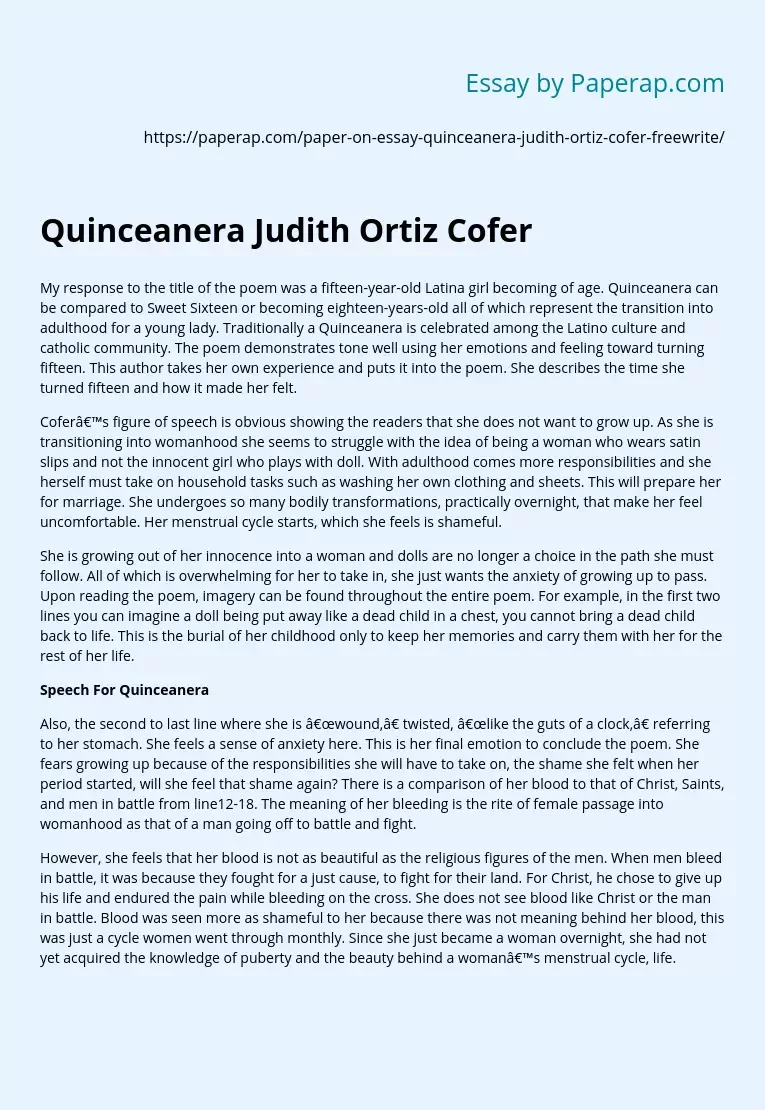Quinceanera Judith Ortiz Cofer
My response to the title of the poem was a fifteen-year-old Latina girl becoming of age. Quinceanera can be compared to Sweet Sixteen or becoming eighteen-years-old all of which represent the transition into adulthood for a young lady. Traditionally a Quinceanera is celebrated among the Latino culture and catholic community. The poem demonstrates tone well using her emotions and feeling toward turning fifteen. This author takes her own experience and puts it into the poem. She describes the time she turned fifteen and how it made her felt.
Cofer’s figure of speech is obvious showing the readers that she does not want to grow up. As she is transitioning into womanhood she seems to struggle with the idea of being a woman who wears satin slips and not the innocent girl who plays with doll. With adulthood comes more responsibilities and she herself must take on household tasks such as washing her own clothing and sheets. This will prepare her for marriage.
She undergoes so many bodily transformations, practically overnight, that make her feel uncomfortable. Her menstrual cycle starts, which she feels is shameful.
She is growing out of her innocence into a woman and dolls are no longer a choice in the path she must follow. All of which is overwhelming for her to take in, she just wants the anxiety of growing up to pass. Upon reading the poem, imagery can be found throughout the entire poem. For example, in the first two lines you can imagine a doll being put away like a dead child in a chest, you cannot bring a dead child back to life.
This is the burial of her childhood only to keep her memories and carry them with her for the rest of her life.
Speech For Quinceanera
Also, the second to last line where she is “wound,” twisted, “like the guts of a clock,” referring to her stomach. She feels a sense of anxiety here. This is her final emotion to conclude the poem. She fears growing up because of the responsibilities she will have to take on, the shame she felt when her period started, will she feel that shame again? There is a comparison of her blood to that of Christ, Saints, and men in battle from line12-18. The meaning of her bleeding is the rite of female passage into womanhood as that of a man going off to battle and fight.
However, she feels that her blood is not as beautiful as the religious figures of the men. When men bleed in battle, it was because they fought for a just cause, to fight for their land. For Christ, he chose to give up his life and endured the pain while bleeding on the cross. She does not see blood like Christ or the man in battle. Blood was seen more as shameful to her because there was not meaning behind her blood, this was just a cycle women went through monthly. Since she just became a woman overnight, she had not yet acquired the knowledge of puberty and the beauty behind a woman’s menstrual cycle, life.
Quinceanera Judith Ortiz Cofer. (2019, Dec 05). Retrieved from https://paperap.com/paper-on-essay-quinceanera-judith-ortiz-cofer-freewrite/

